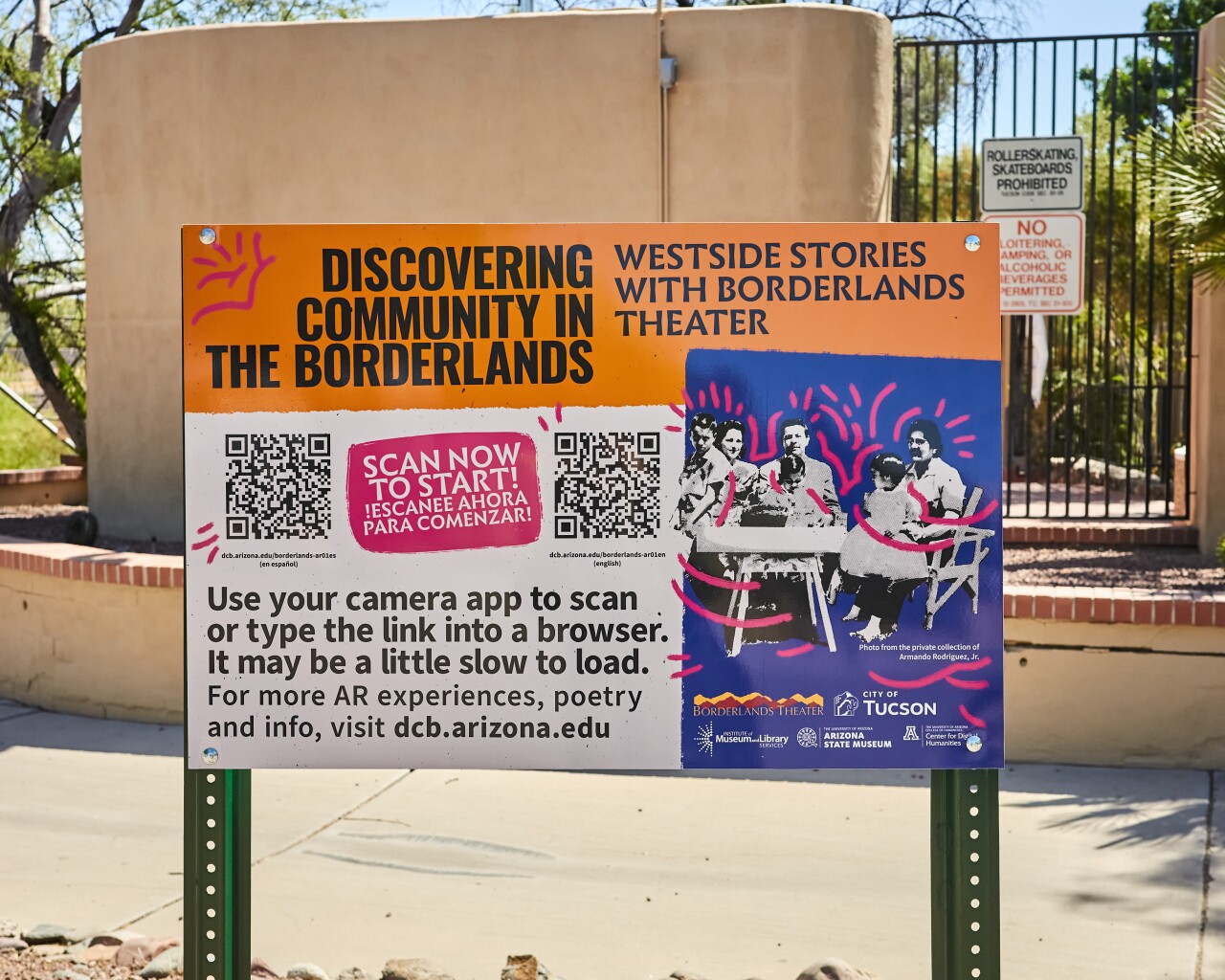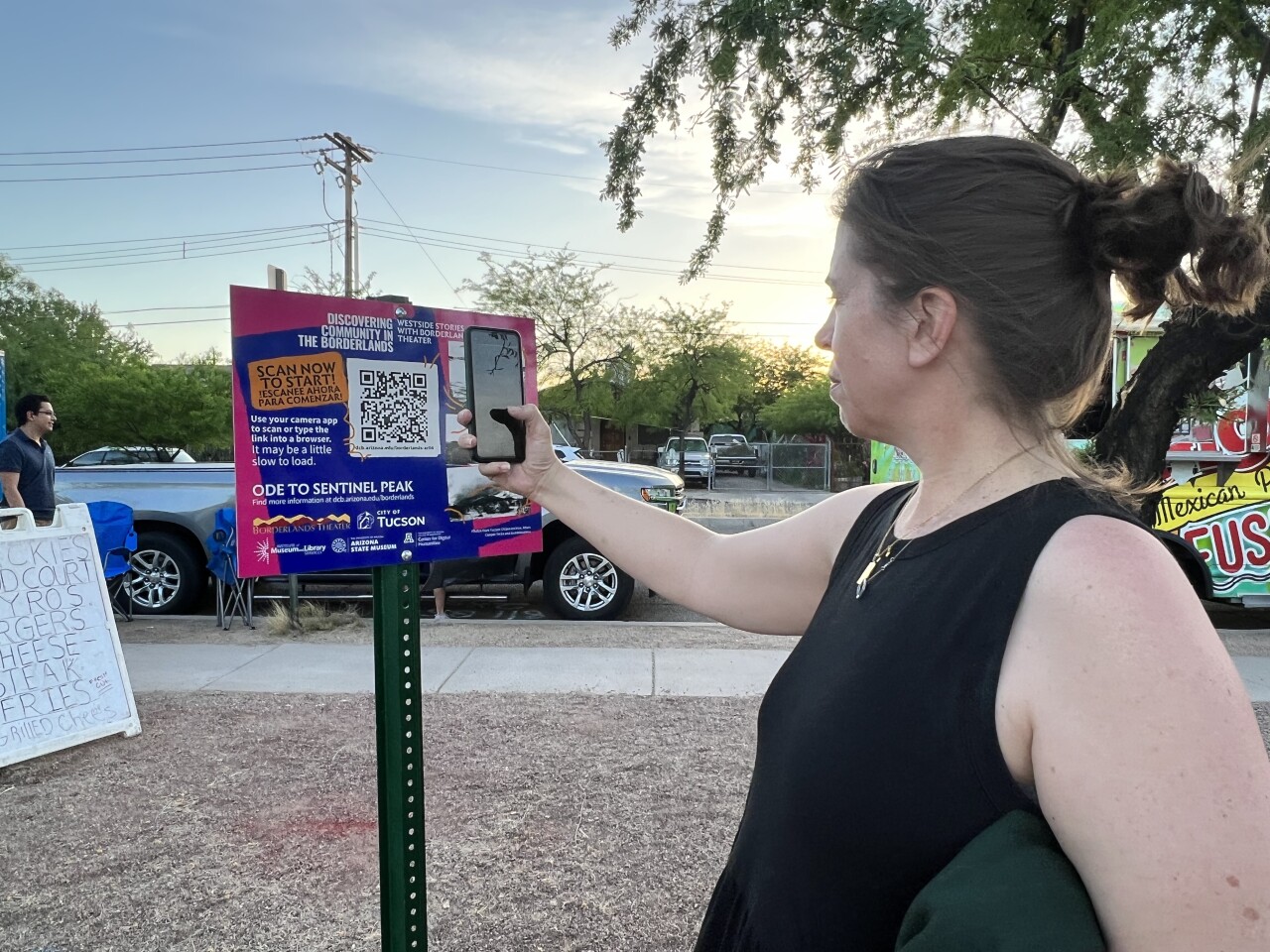At Bonita Park, a small slice of tranquility on Tucson’s west side, a leisurely walk through the green grass running parallel to the Santa Cruz River can quickly turn into a history lesson.
Brightly colored metal signs throughout the park hold QR codes that anyone with a smartphone can access.
Scan those codes and you are greeted on your screen by decades of west-side Tucson history: black-and-white images of Chinese markets; floating newspaper clippings documenting the Garden of Gethsemane public sculpture park; actors reciting oral histories of the area's businesses and residents.

“The signs are very accessible, which is something we like,” said Marc David Pinate, producing artistic director with Borderlands Theater, the theatrical ensemble that helped compile the materials. “It is something that anybody in the park can access. Anytime you are there and have a phone with you, you can see the history.”
These history lessons via augmented reality can be found at points all over Tucson, thanks to a new project spearheaded by the Arizona State Museum and the University of Arizona's Center for Digital Humanities.
Dubbed Discovering Community in the Borderlands, it officially launched on Wednesday, Aug. 30, after several years in the making.
The idea was born from the pandemic, said Lisa Falk, head of community engagement and curator of education at Arizona State Museum.
Falk said the museum, partnering with Center for Digital Humanities and UA Poetry Center, was “trying to get funding to do something that could happen safely outside for people. Something that would be an exhibit about the diverse communities and histories of Tucson.”
The idea they came up with was using augmented reality, an interactive experience where the real world is enhanced by computer-generated elements, such as holograms, 360-degree videos and 3D objects, to share the history and culture of the city.

Once a $190,953 grant from the Institute of Museum and Library Services was in place, the UA tapped several community partners to help bring the idea to fruition. Among the participants: the Dunbar Pavilion, Mission Garden, the Pascua Yaqui Department of Language and Culture and the Tucson Chinese Cultural Center.
Each community partner was tasked with coming up with the materials and overall concept of their augmented reality experience.
Mission Garden, a living agricultural museum that grows produce representing the cultural diversity of Tucson, incorporated poetry spoken in English, Spanish, Chinese, O'odham and Yoeme into a 360-view of the garden grounds.
Dunbar Pavilion, once home to Tucson's first and only segregated school, now a center celebrating African American history and culture, chose to showcase a virtual gallery of historical photos, a slide dance demonstration and a declaration recitation from Dunbar Board member Sam Brown.

The Tucson Chinese Cultural Center opted to roll out their augmented reality experiences in two parts.
Part one focuses on the center’s school. Visitors to the cultural center can scan the QR code in the lobby and watch a Chinese yo-yo demonstration or a young woman playing the traditional plucked zither known as the guzheng.
Part two looks at what Tucson’s Chinese community lost during urban renewal in the 1960s, when a large section of downtown was razed to make way for the Tucson Convention Center.
Scan that QR code on the Tucson Convention Center campus near the Linda Ronstadt Music Hall and you’ll receive a history lesson on the Chinese community that lived in that part of downtown Tucson from the early 1900s until 1968. You can also examine 3D scans of pieces excavated from the area during urban renewal; an opium pipe, translated letters to and from China, Tohono O’odham baskets.
“The baskets show that the communities were not isolated,” said Robin Blackwood, a longtime volunteer and spokeswoman with the Tucson Chinese Cultural Center. “They were trading, buying, selling, interacting.”
Borderlands Theater jumped on the project pretty early in the process, Pinate said.
They had already compiled a lot of the historical information from residents in neighborhoods like Menlo Park and Barrio Hollywood through their West Side Stories series.
“We were very open to it,” Pinate said. “It is a great tool, a great resource. It used our theatrical know-how. We were still writing scripts. You always do a lot of research in theater. We cast actors. All the traditional aspects of theater are in it.”
Falk, who also included the Arizona State Museum in the project, said she could see more augmented reality experiences at more historical sites in the future, provided they could find the funding.
“As a land-grant university, we want to serve communities and we want communities to benefit from the knowledge and resources of the university, as well."
Check out all of the details and experiences you can visit around Tucson at https://dcb.arizona.edu
——-
Gerald Gay is digital content producer who comes from the world of print journalism where he spent two decades covering life in Tucson for the Arizona Daily Star before joining the KGUN 9 team. Share your story ideas with Gerald by emailing gerald.gay@kgun9.com.



